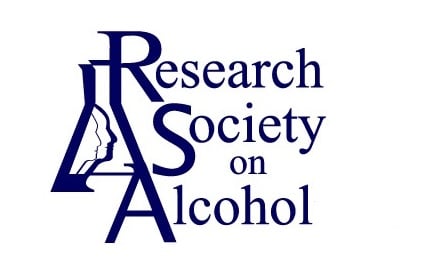Journal list menu
Export Citations
Download PDFs
ISSUE INFORMATION
ARTICLES OF PUBLIC INTEREST
BIOCHEMISTRY, PHARMACOLOGY, PHYSIOLOGY AND METABOLISM
Conditioned social preference and reward value of activating oxytocin-receptor-expressing ventral tegmental area neurons following repeated daily binge ethanol intake
- Pages: 194-206
- First Published: 29 December 2021
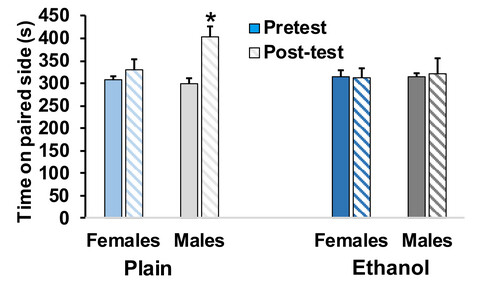
Daily binge ethanol intake selectively decreases the reward value of social interactions in male mice. This deficit is not due to non-specific effects on cognitive, locomotor or anxiety-like behaviors. At the same time, daily binge ethanol decreases positive reinforcement caused by activating VTA neurons that are actively expressing oxytocin receptors, while not affecting the number of those neurons. Thus, subtle dysregulation of oxytocin receptor expression may be related to the social reward deficits caused by daily binge ethanol.
NEUROSCIENCE
Astrogliosis and compensatory neurogenesis after the first ethanol binge drinking-like exposure in the adolescent rat
- Pages: 207-220
- First Published: 03 December 2021
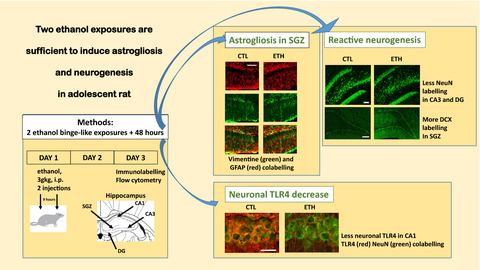
The hippocampal cognitive and synaptic plasticity impairments following two binge ethanol exposures in adolescent rat did not induce microglial reactivity but are associated with hippocampal structural plasticity changes, astrogliosis, reduced mature neurons density, while enhancing the number of new immature neurons generated in the subgranular zone of dentate gyrus. Results suggest that two binge-like ethanol exposures can induce synaptic plasticity disturbances in CA1 by decreasing TLR4 expression in neurons, but not in glial cells.
PATHOLOGY, IMMUNOLOGY AND DEVELOPMENT
Profiling of extracellular vesicle-bound miRNA to identify candidate biomarkers of chronic alcohol drinking in nonhuman primates
- Pages: 221-231
- First Published: 15 December 2021
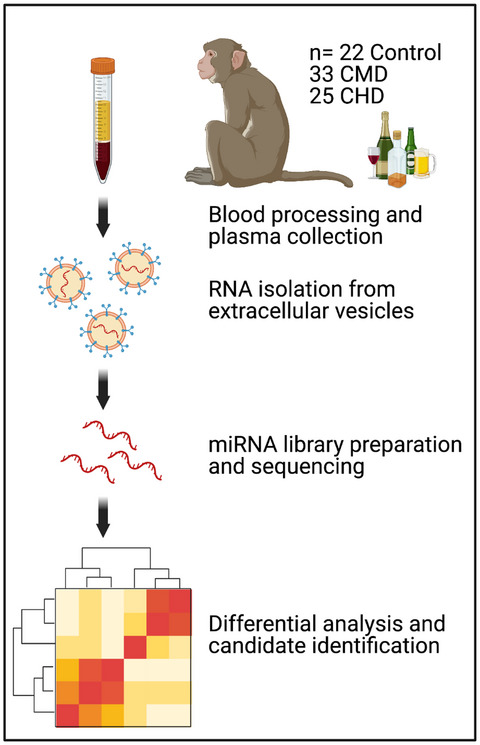
Due to the complex nature of human drinking behavior, it has been challenging to identify reliable biomarkers of alcohol use that could be used to determine drinking behavior prior to signs of overt organ damage. This study profiles the plasma EV-miRNA content of 80 non-human primates after 12 months of voluntary ethanol drinking by miRNA-Seq. We identified several EV-miRNA that could serve as biomarkers of long-term alcohol drinking as well as provided a mechanism for alcohol-induced peripheral inflammation.
EPIDEMIOLOGY, DIAGNOSIS AND COMORBIDITY
Prenatal alcohol exposure and mental health at midlife: A preliminary report on two longitudinal cohorts
- Pages: 232-242
- First Published: 14 February 2022
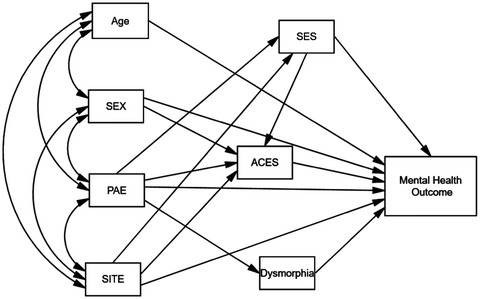
A long-term follow up of adults from two longitudinal cohorts with prenatal alcohol exposure (PAE) finds an association with significantly increased rates of mental health disorders at midlife as well as adverse early life events. Outcomes appear to result from multiple stressors affecting individuals made vulnerable by their early exposure. Clinical outcomes could be improved by prevention efforts directed at both prenatal alcohol use and later environmental stressors, and by early identification of PAE and its effects.
Quantitation of phosphatidylethanols in dried blood spots to determine rates of prenatal alcohol exposure in Ontario
- Pages: 243-251
- First Published: 23 December 2021
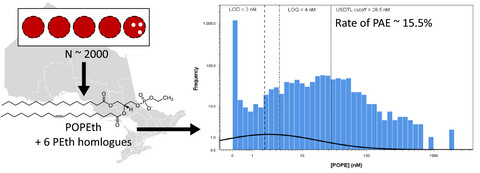
The rate of prenatal alcohol exposure (PAE) in a sample of neonates from Ontario was estimated by quantifying 16:0/18:1 phosphatidylethanol (POPEth) in newborn screening samples. The rate of PAE was 15.5%, which is higher than previous estimates. Six additional PEth homologues were also quantitated and most showed good correlation with each other. Any detectable POPEth was associated with low birthweight, and being POPEth-positive was also associated with preterm birth and lower odds of being small-for-gestational age.
BEHAVIOR, TREATMENT AND PREVENTION
Health-related quality of life is dynamic in alcoholic hepatitis and responds to improvement in liver disease and reduced alcohol consumption
- Pages: 252-261
- First Published: 03 December 2021
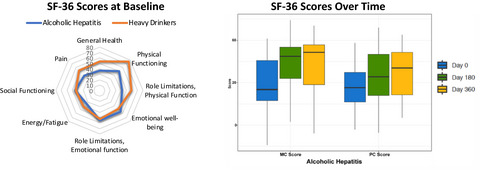
We measured health related quality of life (HRQOL) in alcoholic hepatitis and heavy drinkers using the Short Form Health Survey (SF-36). We show that mental component (MC) scores were associated with demographic characteristics while physical component (PC) scores were associated with liver disease parameters. Over 1-year, HRQOL improved in alcoholic hepatitis; PC scores increased with improved MELD and MC scores increased with abstinence. There were larger increases in both PC and MC scores with resolution of ascites and hepatic encephalopathy.
Addressing methodological issues in a study of impulsivity and vulnerability for transition to alcohol use disorder
- Pages: 262-276
- First Published: 02 December 2021

We examined behavioural impulsivity in adolescent/young adult at-risk drinkers. Online protocols were utilised to facilitate a large sample. Impulsivity differences were assessed as a function of various at-risk alcohol intake categories. Heightened impulsivity was not evident in heavy, standard binge, high binge, harmful, or hazardous alcohol drinkers, as compared to controls, regardless of criteria employed to categorise these individuals. Impulsivity did not predict elevated alcohol use in the form of an alcohol use index.
Reciprocal associations between implicit attitudes and drinking in emerging adulthood
- Pages: 277-288
- First Published: 13 February 2022
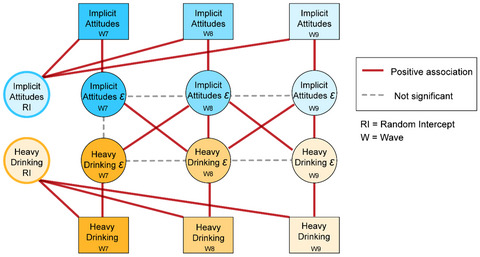
This study used the EZ-diffusion model to distinguish multiple processes impacting responses on an Implicit Association Task (IAT) and disaggregated within- and between-person associations between implicit alcohol attitudes and emerging adult heavy drinking. Results supported drift rate as an index of implicit alcohol attitudes and prospective within-person reciprocal associations between positive attitudes and heavy drinking. The diffusion model enhances construct validity of IAT-assessed implicit attitudes and it is important to distinguish within- and between-person associations when testing dual process theories.
Dissociative symptomatology mediates the relation between posttraumatic stress disorder severity and alcohol-related problems
- Pages: 289-299
- First Published: 18 February 2022

Posttraumatic Stress Disorder (PTSD) is frequently comorbid with alcohol use and its related problems. Dissociation is associated with greater severity of PTSD symptoms. However, the mediating role of dissociation on the relation between PTSD severity and alcohol related problems has not been examined. Our study illustrates that dissociation plays a key mediating role in the relation between PTSD severity and alcohol related problems. Thus, targeting dissociative symptomatology in treatment may prove helpful for individuals with PTSD endorsing problematic alcohol use.
Reduced calibration between subjective and objective measures of episodic future thinking in alcohol use disorder
- Pages: 300-311
- First Published: 18 February 2022
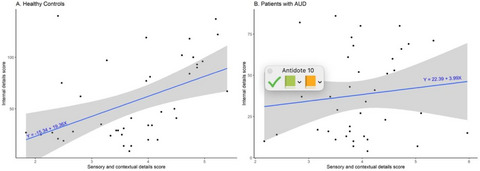
Imagining future scenarios with vividness and specificity—referred to as episodic future thinking (EFT)—is a core aspect of goal-directed actions and sustained motivation. We sought to better understand the calibration between the phenomenological characteristics and objective content of EFT in patients with a severe alcohol-use disorder (AUD) versus matched healthy participants. We demonstrated a distorted self-assessment of the richness of imagined future events in AUD, possibly due to limitations of metacognitive abilities and verbal descriptions of imagined events.
Abstinence versus moderation recovery pathways following resolution of a substance use problem: Prevalence, predictors, and relationship to psychosocial well-being in a U.S. national sample
- Pages: 312-325
- First Published: 21 December 2021
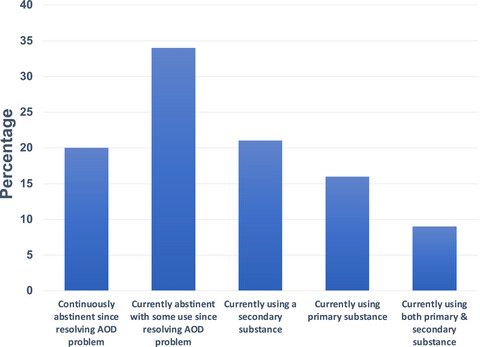
Many people who report resolving an alcohol or other drug (AOD) problem continue some level of substance use. Little information exists, however, regarding the prevalence of this resolution pathway, or its relationship to functioning and well-being. We analyzed data from a nationally representative sample. About half of Americans who have resolved an AOD problem continue to use AOD in some form, however, AOD abstinence versus continued use was associated with greater functioning and well-being.
Naltrexone moderates the association of alcohol use and affect among adolescent drinkers in daily life
- Pages: 326-337
- First Published: 27 December 2021
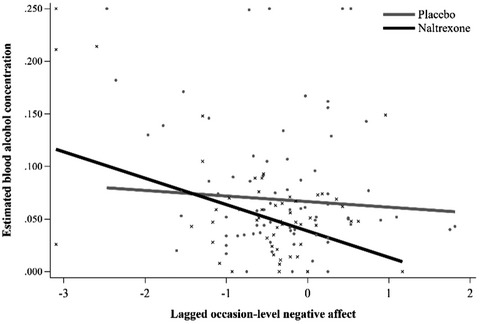
We examined whether naltrexone disrupts the affectively reinforcing properties of alcohol use in the daily life of adolescents with alcohol-related problems. Naltrexone moderated the bidirectional association of alcohol use and affect in adolescents, with effects emerging later in drinking episodes. When taking naltrexone, participants reported more negative affect after drinking and drank less in response to positive affect (at drink initiation) and negative affect (as drinking continued).





